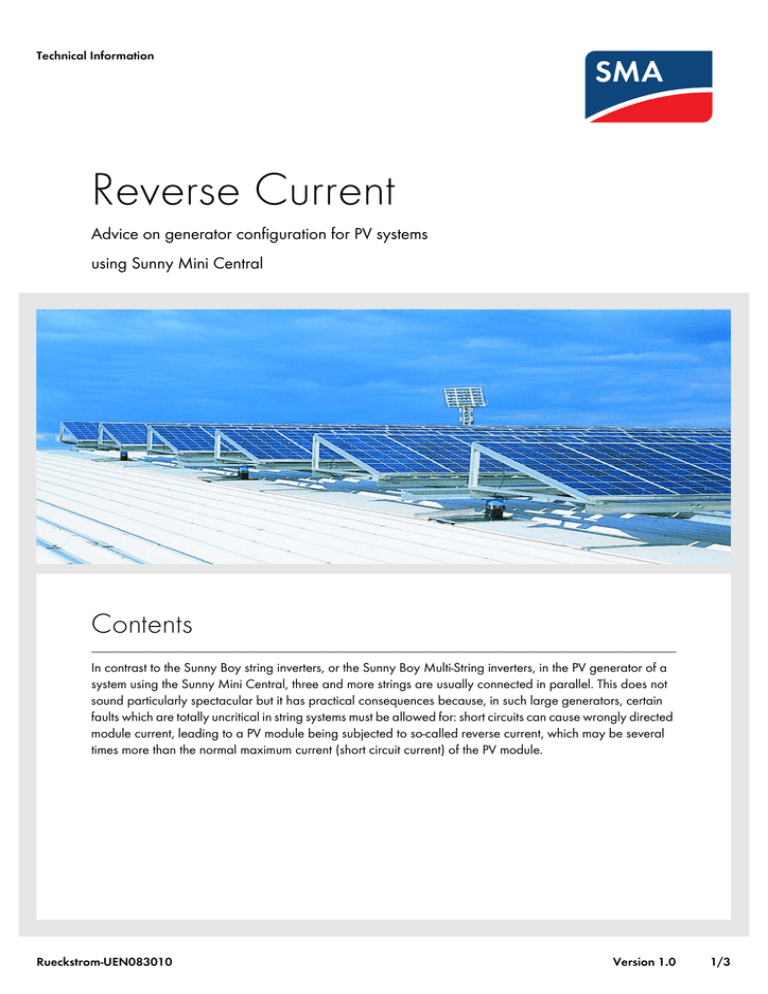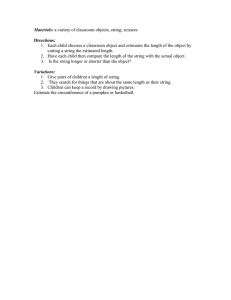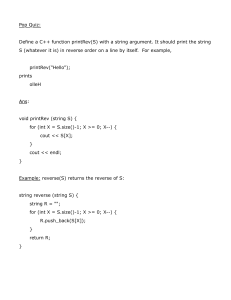Reverse Current - Advice on generator configuration for
advertisement

Technical Information Reverse Current Advice on generator configuration for PV systems using Sunny Mini Central Contents In contrast to the Sunny Boy string inverters, or the Sunny Boy Multi-String inverters, in the PV generator of a system using the Sunny Mini Central, three and more strings are usually connected in parallel. This does not sound particularly spectacular but it has practical consequences because, in such large generators, certain faults which are totally uncritical in string systems must be allowed for: short circuits can cause wrongly directed module current, leading to a PV module being subjected to so-called reverse current, which may be several times more than the normal maximum current (short circuit current) of the PV module. Rueckstrom-UEN083010 Version 1.0 1/3 Technical Information How Does Reverse Current Occur? 1 How Does Reverse Current Occur? In principle, reverse current can only occur when modules are connected in parallel and the open circuit terminal voltage (open circuit voltage UPV 0) of the individual parallel strings is different. In normal operation, this is avoided adequately when the strings are of the same length. Since shadowing of the modules has no significant effect on UPV 0, even in this situation no significant reverse current occurs. In fault-free operation of a correctly dimensioned PV generator, no excessive reverse current can occur. This is not the case if a fault in the PV generator (e.g. short circuit in one or more modules) causes the open circuit terminal voltage of a module string to be significantly lower than the open circuit terminal voltage of other parallel strings. In the worst case, the voltage on the faulty string may lie within the MPP voltage (UMPP) of the remaining generator elements. The internal diode structure of the solar cells causes reverse current to flow through the faulty generator string that, depending on the strength of the current, may lead to excessive heating or destruction of the modules in this string. Among other symptoms, the following faults may lead to reduction of the open circuit terminal voltage of a generator string and subsequent reverse current in parallel-connected systems: • Short circuit in one or more modules • Short circuit in one or more cells in a module • Double ground fault in a module and/or the cabling Despite the fact that these faults are very unlikely, and extremely rare in practice, appropriate preventive measures must still be taken. After all, these types of faults carry a high potential for damage and danger, since all modules in the affected string may be damaged and the local heating may also cause secondary damage. Reverse current into the faulty string = total current of the remaining strings Short circuit! SMA Solar Technology AG + L - N 2/3 Technical Information How Can Reverse Current in the Modules be Prevented? 2 How Can Reverse Current in the Modules be Prevented? First we must explain that bypass diodes, which are the current state-of-the-art in module construction, do not influence the reverse current in the module, but only reduce the effect of any shadowing which may occur. In order to prevent or to limit the reverse current into the modules, the following standard methods can be applied: 2.1 String Technology All components in a string (modules, cable cross-section, plug connectors) must be designed as reverse current for the remaining generator short-circuit current. In the case of a parallel connection of a maximum of two strings, this is always so, since the resulting reverse current of a (defective) string can reach no higher value than that of the short circuit current of the (intact) string. 2.2 String Diodes The so-called string diodes connected in series with the individual strings prevent any reverse current in the corresponding string. Disadvantage: The diode is always connected in series to the corresponding generator string, the string current flows through it and leads to correspondingly high continuous losses. Moreover, the failure of the diode may cause the loss of the safety function or lead to the failure of the entire string. 2.3 String Fuses String fuses connected in series to the individual strings can limit the reverse current in the corresponding string to the permitted maximum. The losses at the string fuses are significantly lower than those of string diodes. Failure of a string fuse can be detected by monitoring the fuse or by intelligent fault monitoring of the PV generator. The Sunny Mini Central 9000TL / 10000TL / 11000TL inverters are already equipped with an integrated, monitored string fuse unit. Detailed information on the choice of fuses and approved fuse types can be found in the technical information "Application of string fuses of Sunny Mini Central 9000TL/10000TL/11000TL" in the download area at www.SMA.de. SMA Solar Technology AG 3/3




